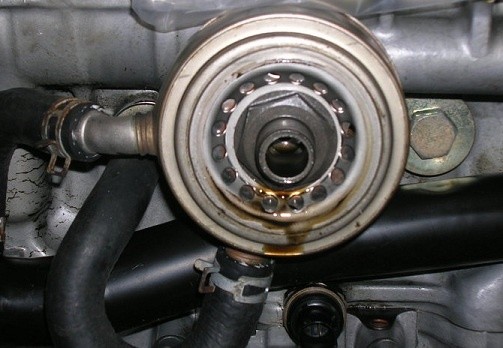Subjects:
- Heat exchanger applied in the engine oil circuit
- Other applications with a heat exchanger
Heat exchanger applied in the engine oil circuit:
The heat exchanger of the oil circuit ensures that the oil is heated up more quickly with an engine that has just started (ie is not yet at operating temperature). The coolant warms up fairly quickly, but the engine oil usually takes twice as long until it has reached the same temperature of about 2 degrees. By using a heat exchanger, the (warm) coolant in the housing flows close to the (cold) engine oil, which is then is warmed up.
When the engine has been at operating temperature for some time and is heavily loaded, the temperature of the engine oil shoots up to above 100 degrees. The operation of the heat exchanger now creates the opposite effect: the constant coolant temperature of 90 degrees cools the engine oil as much as possible again. That is why this component is called a heat exchanger: One time it heats up the engine oil, another time it cools the oil.
The illustration below shows an engine oil circuit heat exchanger. This is often referred to as the oil cooler. However, this is not entirely correct, because when the engine is cold, this actually warms up the oil. The 2 hoses that are mounted on the housing are coolant hoses. The coolant circulates in the round housing. The oil filter is mounted on this side of the housing. This oil filter covers the entire front of this housing. The hole on the inside is the supply of engine oil to the filter and from the small holes on the outside the engine oil is fed back into the engine block.

Other applications with a heat exchanger:
Not only the engine oil is brought up to temperature by means of a heat exchanger. Many other components in the car also work with this principle:
- Radiator: The radiator is also seen as a heat exchanger; the coolant temperature is given off to the air flowing past.
- Heater radiator: The interior air flows through the heater radiator. This has a temperature of around 90 degrees and therefore heats up the interior air.
- Air conditioning condenser: The warm R134a is cooled by the condenser, because (as with the radiator) the wind flows through it.
- Air conditioning evaporator: The warm outside air flows through the evaporator and is cooled down considerably before being blown into the interior.
- EGR cooler: The exhaust gases returned to the engine by the EGR are cooled by the coolant.
- Intercooler: The compressed air from the turbo flows through the intercooler and is then cooled by the outside air before going to the engine inlet.
